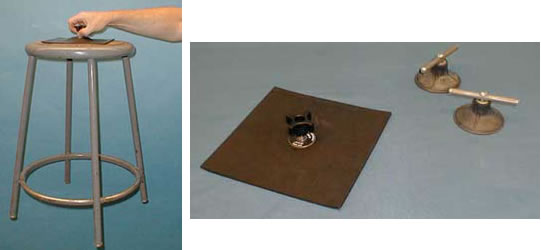Demos: 2A-01 Suction Cups

This simple demonstration introduces the basic ideas about air pressure. A common small suction cup with handle attached, is pressed against a flat, smooth surface. It is extremely difficult to remove, until one edge of the cup is gently lifted. One can also press two such cups together and try to pull them apart. A more dramatic version is to place a large circular rubber sheet on the flat seat of a stool. By pulling up quickly, the stool can be lifted off the floor.
Directions: Using the small black suction cups, either press the two together or press one onto a flat surface, such as a desk top. As an approximation to the amount of pressure force holding the cup against the surface, assume a 3” diameter and a total vacuum inside. Then
This is the upper limit, but shows how large pressure forces can be generated over a relatively small area.
Suggestions for Presentation: Lay the suction cup on the table and show that it is very easy to pick up. Why? Isn’t there a large pressure force from the atmosphere? (Do the calculation above.) After establishing that pressure forces from below neutralize those from above, then ask what happens if we eliminate the air from beneath the cup. Challenge question: If two cups are pushed together and there is a pressure force from each side, does this make it twice as difficult to separate? (Think about Newton’s Laws here. This is similar to the von Guericke experiment. See Demo 2A - 2.)
Using a flexible rubber sheet having a handle attached, lift a stool from the floor by placing the sheet on the stool seat and lifting quickly. Too slow a lift will allow air to get underneath before the pressure difference has a chance to make the seal.
Applications: Commercial uses of suction cups, flexible seals on refrigerator doors. In the latter case, you can show that because of the large surface area of the refrigerator door, a difference of only 0.1 lb/in2 can generate a pressure force of over 200 lbs. That pressure difference arises when the door is opened slightly but the seal has yet to break loose. Be aware that this isn’t a perfect seal--if it were, it would be almost impossible to open the door.
Last Updated: Nov 30, 2023 11:25 AM